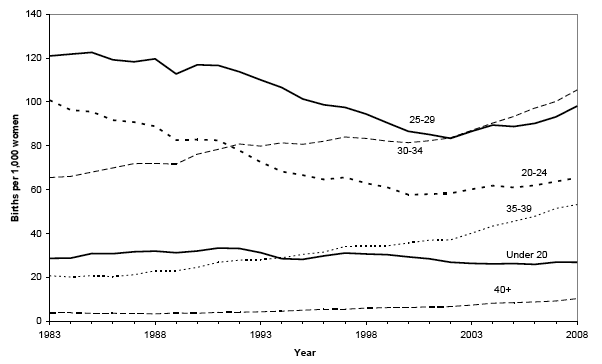
Fertility assumptions are agreed in two stages. The long term assumption is decided as part of the consultation process between the UK countries and the Office for National Statistics. Then there is detailed assumption setting to produce the age-specific fertility rates for each year of the projection period that are consistent with this long-term assumption.
The fertility assumption of long term average completed family size is slightly higher for Scotland in the 2008-based projection than it was in the 2006-based projection. However it is still lower than the assumptions for other UK countries. The assumptions for Scotland and other constituent countries of the UK are given in Table A1.
Table A1 Assumptions of long-term average completed family size 2006 and 2008-based projections
2008-based |
2006-based |
|
|---|---|---|
England |
1.85 |
1.85 |
Wales |
1.85 |
1.85 |
Scotland |
1.70 |
1.65 |
Northern Ireland |
1.95 |
1.95 |
United Kingdom |
1.84 |
1.84 |
Recent data have shown increases in fertility rates over the past seven years. Fertility rates for women in their thirties have continued their sustained increase over recent decades, while fertility rates for women in their twenties have been increasing since 2001.
The trends in age specific fertility for Scotland are shown in Figure A1. Until 2002, there is a general pattern of falling fertility at younger ages coupled with rises in fertility at older ages. From 2002, with the exception of the under 20 group, there have been increases in fertility.
Figure A1 Scotland Age Specific Fertility 1983-2008

Fertility assumptions are formulated in terms of the average number of children that women born in particular years will have. This cohort measure of fertility is more stable than the analogous calendar year or period measure (the total fertility rate). This is because it is affected only by change in the total number of children women have and not by the timing of births within their lives. Period rates may rise or fall if births are brought forward or delayed for any reason.
The assumptions about completed family size are based on family building patterns to date and other relevant data. For the UK as a whole, the steady decline in achieved family size at each age, a clear pattern for the 1945 to 1975 cohorts, appears to be bottoming out among the most recently-born cohorts of women.
The fertility assumptions used in the projection are based on the recession having a small impact on period fertility in the short-term but rates at all ages remaining at a fairly high level. Among women aged 22 and above, rates increase in 2008 but then fall gradually to levels seen in 2006 (for women in their twenties) or slightly higher (for women in their thirties and forties where rates stabilise around levels seen around 2006-2007) by 2014.